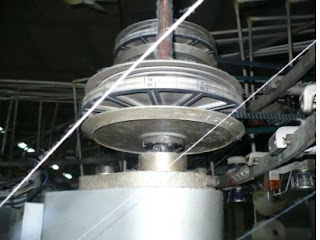Circular Knitting Machine’s Parts of and Their Function
Circular Knitting Machine’s
Parts of and Their Function
Knitting:
Knitting is a method of constructing fabric by interlocking series of loop of one or
more yarns. The word “Knitting” derived from the original Anglo Saxon words
“Cnyttan” which means to weave threads by hand. Original Knitting was by hand
on straight or round needles by slipping stitches from one needle to another,
resulting in a new stitch with each change.
Types
of Knitting: There are two types of Knitting:
Warp Knitting
Weft Knitting
Warp
Knitting:
In
warp knitting, one or two yarn produce vertical column of loops and fabric is
produced at length way. In a warp structure, each loop in the horizontal
direction is made from a different thread and the no of threads used to produce
such a fabric is at least equal to the number of loops in horizontal raw. In
warp knitting, the threads run thoroughly in a vertical direction. For example,
Net, Mesh fabric etc.
Weft or Circular Knitting:
In weft knitting, one yarn
produces a horizontal row of loops and fabric is produced at width way. In a
weft knitted structure, a horizontal raw of loops can be made by using one
thread and the thread runs in horizontal direction. e.g. – single jersey, rib,
interlock etc.
Circular
Knitting Machine:
Circular knitting machine is widely used throughout the
knitting industry to produce fabric. This machine can be built in almost any
reasonable diameter and the small diameter of up to five, which are used for
wear.
Machine for outerwear and under wear may vary from 12 inch
to 60 inch in diameter according to manufactures requirement. This machine can
be used either as fabric or for making garments completely with fancy stitch.
Latch needles are commonly employed in all modern circular machines because of
their simple action and also their ability to process more types of yarns.
Plain circular
m/c uses only one sets of needles, circular rib m/c uses two sets of needles i, e, Cylinder needle and Dial needle, the interlock circular
knitting m/c also uses two sets of needles by needles are long and short respectively for both dial
and cylinder, that is why multiple design and thick fabric can be produce with that m/c. That m/c
is also called double Jersey m/c.
Description
of knitting parts:
Cam
Cam
is a device which converts rotary machine drive into a suitable reciprocating
action for the needles and other elements. The cams are carefully profiled to
produce precisely-time movement and dwell periods and are two types,
engineering and knitting cams.
Knit
Cam: It moves the needle upward enough to clear the old loop
and receive the new yarn
Tuck
Cam: It moves the needle upward not enough to clear. The old
loop but receive the new yarn
Miss
cam: It does not move the needle upward. The needles neither
clear the old loop nor receive the new yarn.
Sinker:
It
is a thin metal plate with an individual or collective operation approximately
at right angles at the hook side between adjacent needles.
MPF Wheel: Its control the speed of the MPF. Pulley belt
gives motion to the wheel.
Needle: Needle
is a primary knitting element. It gives movement according to the cam
arrangement.
Brush
It
cleans the pulley belt.
Feeder: Feeder
is a device where yarn passes through the knitting section.
Feeder
ring: It
is a ring where all feeders are place together.
Inlet
& outlet stop motion: It
is an important part of the machine. It stops the machine instantly when a yarn
breaks.
Yarn
guide pipe: It
helps the yarn to feed in the feeder & also reduce ply.
Pulley
belt: It
controls the rotation of the MPF wheel.
VDQ
Pulley: It is a very important part of the
machine. It controls the quality of the product. Altering the position of the
tension pulley changes the G.S.M of the fabric. If pulley moves towards the
positive directive then G.S.M decreases and reverse direction G.S.M will increase
























No comments